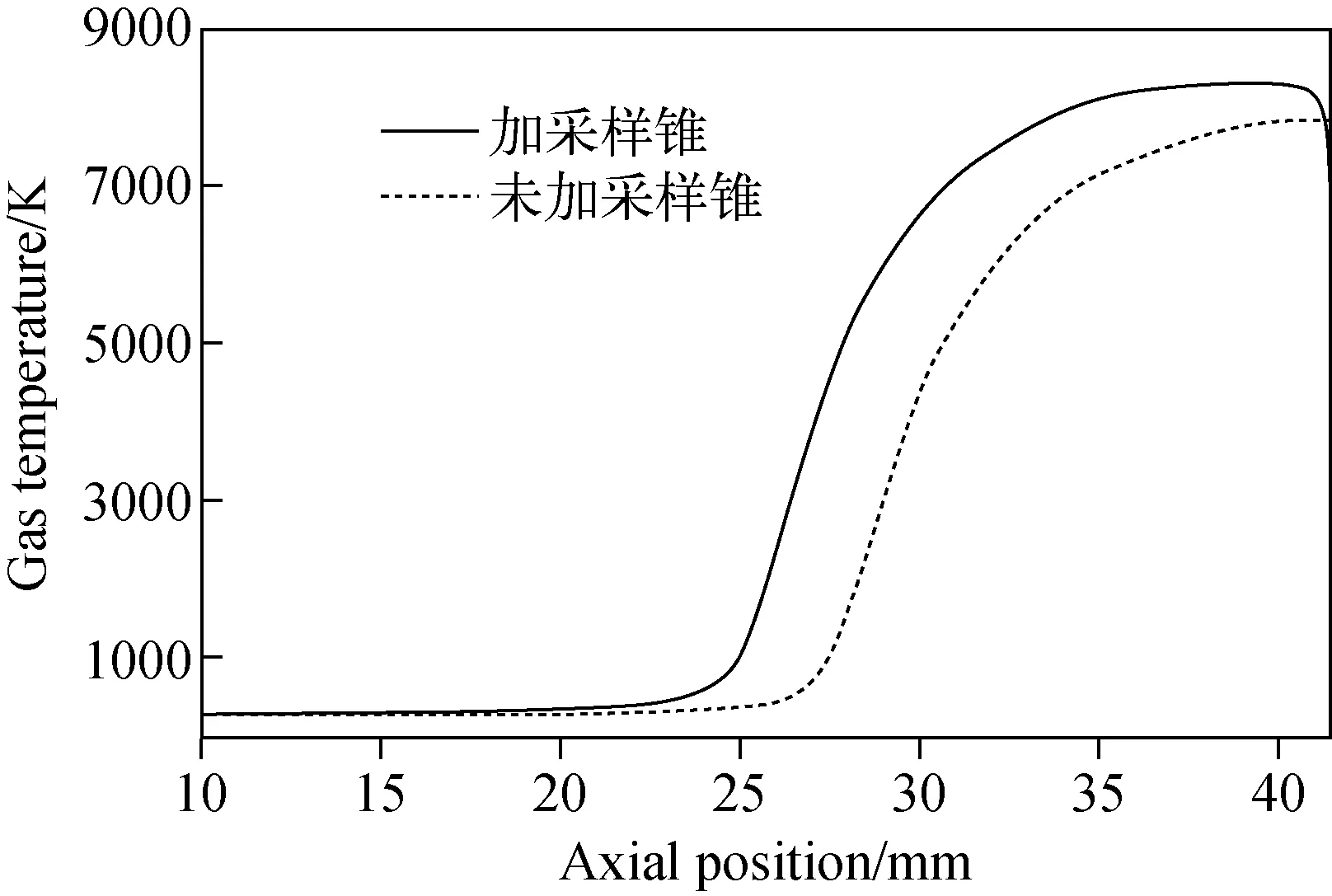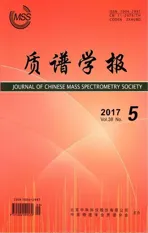电感耦合等离子体离子源气体温度特性数值模拟分析
2017-10-11岳东宁马燕云粟永阳袁祥龙李志明
岳东宁,赵 军,,马燕云,徐 江,粟永阳,汪 伟,袁祥龙,李志明
(1.国防科学技术大学理学院,湖南 长沙 410073;2.西北核技术研究所,陕西 西安 710024)
电感耦合等离子体离子源气体温度特性数值模拟分析
岳东宁1,赵 军1,2,马燕云1,徐 江2,粟永阳2,汪 伟2,袁祥龙2,李志明2
(1.国防科学技术大学理学院,湖南 长沙 410073;2.西北核技术研究所,陕西 西安 710024)
采用以流场为主耦合电磁场的计算流体力学方法分析ICP离子源的温度特性,并比较加载采样锥前后其温度特性的变化。由于采样锥和炬管构成了相对封闭的空间,加载采样锥后大部分区域温度偏高。在采样锥附近等离子体通道效应明显,中心通道温度从25 mm附近开始急剧上升到8 000 K左右,在采样锥口前1 mm左右急剧下降到6 000 K左右。用Discrete Phase Model (DPM)模型分析了不同直径气溶胶颗粒对中心通道气体温度的影响,发现颗粒直径太大会影响中心通道气体温度的稳定性,而直径几微米的气溶胶颗粒电离效率较高。
电感耦合;采样锥;气体温度;数值模拟
Abstract: Computational Fluid Dynamics (CFD) method coupled electromagnetic field is used to analyze thermal characters of inductively coupled plasma (ICP) with and without sampler. The ICP is modeled in an axisymmetric geometry, taking into account the gas streaming into a flowing ambient gas. The flow in the calculation region is assumed to be laminar and the well-known Navier-Stokes equations are used to determine the flow conditions. The time-averaged Axial and Radial Lorentz Force density is taken as Axial and Radial Momentum source respectively. Since the energy loss by emitted radiation is much lower than the coupled electric power density, it is negligible in this numerical simulation. The advantage of choosing CFD commercial software Ansys Fluent is that user-defined scalar (UDS) method can be applied to solve Maxwell’s equations. On the other hand, user-defined function is a convenient way to add Ar-ICP’s physical characters, which can be described by mathematic functions, like viscosity and thermal conductivity. Under the hypothesis of Local Thermal Equilibrium (LTE), electron density and electron temperature can be calculated based on gas temperature. The temperature of Nickel sampler interface cooled by water was set as 1 700 K which is below the melting point of pure Nickel. The flaw of this numerical simulation method was the distribution of electrical conductivityσ(T) which is related to gas temperature. Because several equations need to be solved in the process of iterations, there is no other way to do it ifσ(T) is unpredictable. In this case, the crucial parameter will be missing. But it is contradictory that ifσ(T) is predictable then gas temperature can be predictable too. Although many references setσ(T) as a constant number at the beginning of iterations, a simple mathematical function will help to do better but not perfectly. Besides, the process of how tested element diffuses in ICP is hardly estimated by this model. Gas temperature is a little higher with sampler orifice because it becomes a relatively closed space between ICP torch and sampler. But the nearest area of sampler position has cooler temperature and the effect of plasma central tunnel is stronger. Gas temperature of central tunnel rises fast to about 8 000 K from axial position around 25 mm and drops down quickly to about 6 000 K from axial position around 1 mm in front of sampler position. To study how aerosols with different diameters affect the gas temperature of central tunnel, Discrete Phase Model (DPM) was used. Aerosols with diameters of several microns have higher probability to be ionized.
Keywords: inductively coupled plasma; sampler cone; gas temperature; numerical simulation
自从20世纪第一台商用化仪器问世以来,ICP-MS被广泛应用于环境、高纯材料、核工业、生物医药、地质、考古、化学计量学等诸多领域,现已成为重要的元素分析技术[1]。ICP-MS可以对周期表中多达73种元素进行快速同时分析,且测定灵敏度高、基体效应低,有着良好的精密度和重复性[2]。
ICP放电特性的研究涉及流场、电磁场等多物理场耦合的过程[3-7]。Lindner等[3]分析了27 MHz,1 000 W功率下ICP特性,给出其物性参数并建立了使用Fluent进行数值模拟的基本方法。Cai等[4]研究了大气压下He-ICP的放电特性,并与Ar-ICP的特性进行比较,但没有考虑加载采样锥后对分析特性的影响。Bernardi等[5]研究了3种不同模型下的ICP电磁场分布,为使用Fluent进行电磁场方程求解建立了方法。Xue等[6]研究了不同等离子体电导率下的ICP电磁场分布,为数值模拟提供了重要的参数分析。Punjabi等[8]模拟了高频线圈和负载在不同相对位置下ICP的温度分布,为高频发生器和负载之间能量传递的研究提供理论支持。
本工作将研究ICP的气体温度分布特性,并比较加载采样锥前后温度特性的变化,以了解ICP离子源的工作机理,优化运行参数及改善其分析性能。通过研究气溶胶颗粒对中心通道气体温度的影响,以助于理解样品的电离过程,提高电离效率。
1 构建模型
主流ICP炬管结构呈三管嵌套式轴对称模型,其截面示于图1。工作气体氩气从3个入口进入,模拟采用的流量数值如下:中心气流量0.7 L/min,辅助气流量1 L/min,冷却气流量16 L/min。高频线圈工作频率为27.12 MHz,通有31.81 A电流。在没有采样锥的情况下,整个气压环境为大气压。相对地,在轴向位置41.5 mm处,加载直径D=1 mm的采样锥,锥后为低真空状态,气压设为133.32 Pa。
电感耦合等离子体的发生以及维持是一个多物理场耦合的过程,可采用以流场为主耦合电磁场的计算流体力学(CFD)方法进行数值模拟。同时为了提高运算速度,可对Ar-ICP的物性参数(粘度、热导系数、扩散系数)进行多项式拟合,再代入程序中。多项式拟合方程为:

注:id—内直径;od—外直径图1 ICP炬管结构示意图 Fig.1 Two-dimensional model of ICP torch
物性参数=a1·T5+a2·T4+a3·T3+a4·T2+a5·T+a6
假设Ar-ICP为理想等离子体状态[9-10],其拟合系数列于表1。

表1 多项式拟合系数表Table 1 Polynomial coefficients of physical characters for Ar-ICP
2 结果与讨论
2.1 采样锥对气体温度特性的影响
对Ar-ICP而言,等离子体包含电子、Ar+、Ar原子等3种粒子,使用Fluent 15.0进行多场耦合的数值模拟,等离子体物性参数用UDF编程描述,电磁场拉普拉斯方程通过UDS在Fluent中进行求解。选取轴向位置10~45 mm,径向位置0~9 mm的范围给出ICP温度分布图,示于图2。温度分布较高的区域集中在轴向位置24 mm,径向位置5 mm附近,整体分布呈现火焰状。由于高频线圈对带电粒子具有磁约束作用[2],会使部分带电粒子产生径向运动,因此会呈现束腰状的火焰分布。越是远离线圈功率密度越低,在矩管末端形成等离子体衰减区[12]。

图2 未加采样锥时,ICP温度分布Fig.2 Gas temperature distribution of Ar-ICP without sampler orifice
加载采样锥后,由于锥后为低真空环境,流场的变化导致等离子体温度特性的改变,其ICP温度分布示于图3。采样锥与炬管构成了一个相对封闭的空间,导致一定的热量未被带出,等离子体温度有一定的升高且锥口前温度相对较高,有利于样品元素的电离。由于采样锥锥壁受到水冷系统的冷却作用,其周围气体温度较低。

图3 加载采样锥后,ICP温度分布Fig.3 Gas temperature distribution of Ar-ICP with sampler orifice
采样锥轴向位置为41.5 mm,依次选取轴向位置41.5、41.4、41.1、40.8、39.5、37.5 mm等处给出ICP温度的径向分布,每两个位置为一组,其气体温度的径向分布示于图4。
第一组位置(41.5 mm,41.4 mm)接近采样锥,其温度的径向分布示于图4a和4b。可见,在加载采样锥后,其锥口(直径1 mm)范围内气体流速非常快且温度偏低,等离子体通道效应更加明显。
第二组位置(41.1 mm,40.8 mm)稍偏离采样锥,温度径向分布示于图4c和4d。对比图4a和4b可知,等离子体通道效应已经明显减弱,且通道中心的温度比周围区域高,此处发生电离的概率较高。
第三组位置(39.5 mm,37.5 mm)更加远离采样锥,受锥后低真空环境的影响很小,温度径向分布示于图4e和4f。由于采样锥与炬管的构成相对封闭,这部分区域的空间效应更加明显。因此,等离子体通道不明显,且温度较不加采样锥时偏高。

— 加采样锥; 未加采样锥注:a.41.5 mm;b.41.4mm;c.41.1 mm;d.40.8 mm;e.39.5 mm;f.37.5 mm;图4 气体温度的径向分布 Fig.4 Radial distribution of gas temperature
2.2 中心通道气体温度分布
由于被测样品通过中心通道时发生热电离,因此,中心通道的温度分布是影响仪器分析性能的重要因素之一。中心通道的温度分布示于图5,可见,在接近采样锥时温度急剧下降。通道其他区域的温度在加载采样锥的情况下偏高,可提高样品元素的电离效率。
2.3 雾化液滴直径对中心通道气体温度的影响
将雾化小液滴,即颗粒物直径分别取1、5、10、20、60 μm,用DPM模型模拟进样过程中不同直径气溶胶颗粒对中心通道气体温度的影响。假设进样质量流速为4.854×10-7kg/s,气溶胶颗粒均匀进入中心通道,不同直径的颗粒物对中心通道气体温度的影响示于图6。颗粒物直径越小,对中心通道气体温度的扰动越小,反之,扰动越大。模拟结果显示:直径60 μm的气溶胶颗粒通过中心通道时,未完全被蒸发并导致通道气体温度降低;直径20 μm的气溶胶颗粒虽然完全被蒸发,但对中心通道气体温度的扰动在采样锥前5 mm处才开始降低;直径1、5和10 μm的气溶胶颗粒不仅完全被蒸发,其温度分布对样品元素的热电离也十分有利。相关实验[11]表明,在0.4~3 μm范围内,ICP-MS的探测效率与粒径无关,这与模拟分析的结果一致。

图5 中心通道温度分布Fig.5 Gas temperature of central tunnel

图6 中心通道气体温度随气溶胶颗粒直径的变化Fig.6 Gas temperature of central tunnel changes with different diameters of aerosol
3 结论
本工作针对ICP离子源进行了温度分布的数值模拟,比较了加载采样锥和大气压环境下的两种模拟结果,发现加载采样锥后气体温度会有小幅度升高,但采样锥口附近温度下降。这有利于减少被测元素离子的扩散并增加其通过采样锥的概率。此外,还通过DPM模型分析了不同直径大小的雾化液滴对气体温度的影响,发现直径小于5 μm的液滴对中心通道气体温度的影响最小。若直径大于10 μm的液滴混入中心通道,将会对气体温度造成扰动,从而影响实验测量结果。在等离子体实验诊断困难或条件不足的情况下,采用数值模拟方法可为实验展开和基础研究提供指导。
[1] 刘虎生,邵宏翔. 电感耦合等离子体质谱技术与应用[M]. 北京:化学工业出版社,2005.
[2] 辛仁轩. 等离子体发射光谱分析[M]. 北京:化学工业出版社,2011.
[3] LINDNER H, BOGAERTS A. Multi-element model for the simulation of inductively coupled plasmas: effects of helium addition to the central gas stream[J]. Spectrochimica Acta Part B Atomic Spectroscopy, 2011, 66(6): 421-431.
[4] CAI M. Computer simulation of atmospheric-pressure helium inductively coupled plasma discharges[J]. Spectrochimica Acta Part B Atomic Spectroscopy, 1993, 48(6/7): 789-807.
[5] BERNARDI D, COLOMBO V, GHEDINI E, et al. Comparison of different techniques for the FLUENT©-based treatment of the electromagnetic field in inductively coupled plasma torches[J]. The European Physical Journal D, 2003, 27(1): 55-72.
[6] XUE S, PROULX P, BOULOS M I. Extended-field electromagnetic model for inductively coupled plasma[J]. Journal of Physics D Applied Physics, 2001, 34(12): 1 897.
[7] CAI M, HAYDAR D A, MONTASER A, et al. Computer simulation of argon-nitrogen and argon-oxygen inductively coupled plasmas[J]. Spectrochimica Acta Part B Atomic Spectroscopy, 1997, 52(3): 369-386.
[8] PUNJABI S B, DAS T K, JOSHI N K, et al. The effect of various coil parameters on ICP torch simulation[J]. 2010, 208(1): 012048.
[9] ZAGHLOUL M R, BOURHAM M A, DOSTER J M. A simple formulation and solution strategy of the Saha equation for ideal and nonideal plasmas[J]. Journal of Physics D Applied Physics, 2000, 33(8): 977.
[10] IRWIN A W. Polynomial partition function approximations of 344 atomic and molecular species[J]. Astrophysical Journal Supplement, 1981, 45: 621-633.
[11] 粟永阳,李志明,周国庆,等. ICP-MS在线定量分析气溶胶粒子的技术研究[J]. 分析测试学报,2009,28(4):436-439.
SU Yongyang, LI Zhiming, ZHOU Guoqing, et al. Study of on-line chemical analysis of aerosol individual particles with ICP-MS[J]. Journal of Instrumental Analysis, 2009, 28(4): 436-439(in Chinese).
Numerical Analysis of Gas Temperature in Inductively Coupled Plasma Ion Source
YUE Dong-ning1, ZHAO Jun1,2, MA Yan-yun1, XU Jiang2, SU Yong-yang2, WANG Wei2, YUAN Xiang-long2, LI Zhi-ming2
(1.NationalUniversityofDefenseTechnology,Changsha410073,China;2.NorthwestInstituteofNuclearTechnology,Xi’an710024,China)
O539
A
1004-2997(2017)05-0521-05
10.7538/zpxb.2016.0061
2016-04-15;
2016-11-30
国家重大科学仪器专项(2012YQ250003)资助
岳东宁(1991—),男(汉族),山东荣成人,硕士研究生,激光等离子体专业。E-mail: 1039728678@qq.com
李志明(1973—),男(汉族),湖北浠水人,研究员,从事无机和同位素质谱研究。E-mail: zhiming_li218@sina.com
时间:2017-04-13;网络出版地址:http:∥www.cnki.net/kcms/detail/11.2979.TH.20170413.0925.010.html
